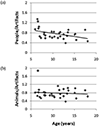The scope of social attention deficits in autism: prioritized orienting to people and animals in static natural scenes
- PMID: 19686766
- PMCID: PMC6102729
- DOI: 10.1016/j.neuropsychologia.2009.08.008
The scope of social attention deficits in autism: prioritized orienting to people and animals in static natural scenes
Abstract
A central feature of autism spectrum disorder (ASD) is an impairment in 'social attention'--the prioritized processing of socially relevant information, e.g. the eyes and face. Socially relevant stimuli are also preferentially attended in a broader categorical sense, however: observers orient preferentially to people and animals (compared to inanimate objects) in complex natural scenes. To measure the scope of social attention deficits in autism, observers viewed alternating versions of a natural scene on each trial, and had to 'spot the difference' between them--where the difference involved either an animate or inanimate object. Change detection performance was measured as an index of attentional prioritization. Individuals with ASD showed the same prioritized social attention for animate categories as did control participants. This could not be explained by lower level visual factors, since the effects disappeared when using blurred or inverted images. These results suggest that social attention - and its impairment in autism - may not be a unitary phenomenon: impairments in visual processing of specific social cues may occur despite intact categorical prioritization of social agents.
Figures





References
-
- Abell F, Happé F, & Frith U (2000). Do triangles play tricks? Attribution of mental states to animated shapes in normal and abnormal development. Cognitive Development. 15, 1–16.
-
- Adolphs R (2003). Cognitive neuroscience of human social behavior. Nature Reviews Neuroscience. 4 165–178. - PubMed
-
- Adolphs R (2006). How do we know the minds of others? Domain-specificity, simulation, and enactive social cognition. Brain Research, 1079, 25–35. - PubMed
-
- Adolphs R, Sears L, & Piven J (2001). Abnormal processing of social information from faces in autism. Journal of Cognitive Neuroscience, 13, 232–240. - PubMed
-
- Adolphs R, & Spezio M (2006). Role of the amygdala in processing visual social stimuli In Anders S, Ende G, Junghofer M, Kissler J, & Wildgruber D (Eds.), Progress in brain research: Vol, 156, Understanding emotions (pp. 363–378). Amsterdam, Netherlands: Elsevier. - PubMed
Publication types
MeSH terms
Grants and funding
LinkOut - more resources
Full Text Sources
Medical

